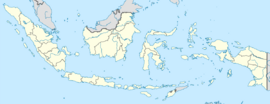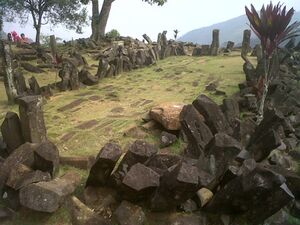Earth:Gunung Padang
 A view of Gunung Padang | |
| Location | Karyamukti, Campaka, Cianjur Regency, West Java, Indonesia |
|---|---|
| Coordinates | [ ⚑ ] : 6°59′38″S 107°03′23″E / 6.99389°S 107.05639°E |
| Type | Megalith |
| Site notes | |
| Discovered | 1890 |
| Archaeologists |
|
Gunung Padang is a archaeological site located in Karyamukti, Campaka, Cianjur Regency, West Java, Indonesia, 30 kilometres (19 mi) southwest of the regency seat or 8 kilometres (5.0 mi) from Lampegan station. Located at 885 metres (2,904 ft) above sea level, the site covers a hill, an extinct volcano, in a series of five terraces bordered by retaining walls of stone that are accessed by 370 successive andesite steps rising about 95 metres (312 ft). It is covered with massive hexagonal stone columns of volcanic origin.[1] The Sundanese people consider the site sacred and believe it was the result of King Siliwangi's attempt to build a palace in one night.[2]
Gunung Padang consists of a series of five artificial terraces, one rectangular and four trapezoidal, that occur, one through five, at successively higher elevations. These terraces also become successively smaller with elevation with the first terrace as the lowest and largest and the fifth terrace as the highest and smallest. These terraces lie along a central, longitudinal NW-SE axis. They are artificial platforms created by lowering high spots and filling in low spots with fill until a flat surface was achieved. The terrace perimeters consist of perimeter retaining walls formed by volcanic polygonal columns stacked horizontally and posted vertically as posts. This terrace complex is accessed by a central stairway with 370 steps, an inclination of 45 degrees, and a length of 110 m (360 ft).[2][3]
History of study
Dutch historian Rogier Verbeek mentioned the existence of the Gunung Padang site in his book Oudheden van Java: lijst der voornaamste overblijfselen uit den Hindoetijd op Java, based on a visit and report by M. De Corte in 1890[4]
The notes on the Gunung Padang site in Verbeek's book are similar to those made by Dutch archaeologist Nicolaas Johannes Krom in the 1914 Rapporten van de Oudheidkundige Dienst (ROD, "Report of the Department of Antiquities").[5]
After 1914, this site was ignored until 1979, when a group of local farmers rediscovered Gunung Padang. This discovery quickly attracted the attention of the Bandung Institute of Archaeology, the Directorate of Antiquities, PUSPAN (now the Center for Archaeological Research and Development), the local government, and various community groups.[2] Throughout the 1980s, these organizations conducted joint archaeological research and restoration work at Gunung Padang. In 1998, the Indonesian Ministry of Education and Culture declared it a heritage site of local interest.[2] At the end of June 2014, the Education and Culture Ministry declared Gunung Padang site a National Site Area, covering a total of 29 hectares (72 acres).[6]
On 1 October 2014, surveyors halted excavation activities temporarily, hoping to begin them again under the new government.[7] The 2014 excavation has been criticized for being improperly conducted.[8]
Age estimates
Archaeologist Lutfi Yondri from the Bureau of Archaeology in Bandung estimated that the constructions at Gunung Padang may have been built sometime between the second and fifth centuries CE, thus in the Indonesian late prehistoric period, whereas Harry Truman Simanjuntak suggested a later date in historical times between the 6th and 8th centuries CE.[9] Pottery fragments found at the site were dated by the Bureau of Archaeology in the range 45 BCE – 22 CE.[10]
Based on carbon dating and stratigraphic studies published in the Journal Archaeological Prospection,[11] Danny Hilman Natawidjaja, an Indonesian geologist who is an expert in earthquake geology and geotectonics, suggested that the site had been built as a giant pyramid 9,000 to 20,000 years ago, implying the existence of an otherwise unknown advanced ancient civilization.[12][13][14] However, none of these radiocarbon dates, along with their stratigraphic context, have been formally published and the age of this site based on these dates differs greatly depending on the publication consulted even when the publications are by the same author explaining the results of the same research.[2]
Fringe dating
Natawidjaja's analysis was questioned by other scientists. Vulcanologist Sutikno Bronto suggested that the carbon dating result was influenced by weathering and concluded that the elevation is the neck of an ancient volcano and not an artificially created pyramid.[14][15] Thirty-four Indonesian scientists signed a petition questioning the motives and methods of the Hilman-Arif team.[14] Archaeologist Víctor Pérez described Natawidjaja's conclusions as pseudoarchaeology.[2]
Natawidjaja's conclusions gained the attention of Indonesia's President Susilo Bambang Yudhoyono, who set up a task force.[2] An archaeologist who did not wish to be named due to the involvement of the country's president, stated:
In archaeology we usually find the 'culture' first … Then, after we find out the artefact's age we'll seek out historical references to any civilisation which existed around that period. Only then will we be able to explain the artefact historically. In this case, they 'found' something, carbon-dated it, then it looks like they created a civilisation around the period to explain their finding.[14]
In October 2023, an article by Natawidjaja et al., published in Archaeological Prospection, claimed that Gunung Padang is the oldest pyramid in the world, dating as far back as 27,000 years ago. Archaeologists, responding to the extraordinary claims, pointed out the lack of evidence for the buried layers being artificially created, and the absence of indicators for human activity in the soil samples, such as charcoal and bone fragments. The journal and its publisher, Wiley, have since launched an investigation into the paper.[16]
See also
References
- ↑ Ramadina, Savitri Putri (2013). "Analisis Perupaan Situs Megalitik Gunung Padang di Cianjur, Jawa Barat". ITB Journal of Visual Art and Design 4 (1): 51–66. doi:10.5614/itbj.vad.2013.4.1.7. https://journals.itb.ac.id/index.php/jvad/article/view/753/454.
- ↑ 2.0 2.1 2.2 2.3 2.4 2.5 2.6 Pérez García, Víctor Lluís (2017). "Gunung Padang y el megalitismo indo-malayo: Arqueología y pseudoarqueología". Arqueoweb: Journal of Archeology on the Internet 18 (1): 62–104. https://webs.ucm.es/info/arqueoweb/pdf/18/04_PerezGarcia.pdf. Retrieved 12 November 2022.
- ↑ Yondri, Lufti (2014). "Punden Berundak Gunung Padang Refleksi Adaptasi Lingkungan dari Masyarakat Megalitik.". Jurnal Sosioteknologi 13 (1): 1–14. doi:10.5614/sostek.itbj.2014.13.1.1.
- ↑ Verbeek, Rogier Diederik Marius (1891) (in nl). Oudheden van Java: lijst der voornaamste overblijfselen uit den Hindoetijd op Java, met eene oudheidkundige kaart. Landsdrukkerij. pp. 43. https://books.google.com/books?id=UNeNVWfsb3oC&q=padang&pg=PA43.
- ↑ Nederlandsch-Indië, Oudheidkundige Dienst in (1914) (in nl). Rapporten. Bataviaasch Genootschap van Kunsten en Wetenschappen.. https://books.google.com/books?id=4ekwAQAAMAAJ.
- ↑ "Balai Pengelolaan Situs Gunung Padang Segera Dibentuk". 2014-06-25. http://jabar.tribunnews.com/2014/06/25/balai-pengelolaan-dibentuk-setelah-penataan-selesai-dilakukan.
- ↑ "Timnas Gunung Padang Hentikan Penelitian". 2014-10-01. http://jabar.tribunnews.com/2014/10/01/timnas-gunung-padang-hentikan-penelitian.
- ↑ Dipa, Arya (2014-09-24). "Archaeologists slam excavation of Gunung Padang site". thejakartapost.com. http://www.thejakartapost.com/news/2014/09/24/archaeologists-slam-excavation-gunung-padang-site.html.
- ↑ Utomo, Yunanto Wiji (2014-06-06). "Mari Terbang ke Atas Situs Megalitikum Gunung Padang". http://sains.kompas.com/read/2014/06/06/1957144/Mari.Terbang.ke.Atas.Situs.Megalitikum.Gunung.Padang.
- ↑ Prasetyo, Bagyo (2015). Megalitik: Fenomena yang berkembang di Indonesia. Jakarta: Pusat Penelitian Arkeologi Nasional. pp. 61. ISBN 9786020818252. https://repositori.kemdikbud.go.id/4657.
- ↑ Natawidjaja, Danny Hilman; Bachtiar, Andang; Nurhandoko, Bagus Endar B.; Akbar, Ali; Purajatnika, Pon; Daryono, Mudrik R.; Wardhana, Dadan D.; Subandriyo, Andri S. et al. (20 October 2023). "Geo-archaeological prospecting of Gunung Padang buried prehistoric pyramid in West Java, Indonesia" (in en). Archaeological Prospection. doi:10.1002/arp.1912.
- ↑ Natawidjaja, Danny Hilman; Bachtiar, Andang; Endar, Bagus; Daryono, Mudrik; Subandrio, Andri. Evidences of Large pyramid-like structure predating 10,000 Year BP at Mount Padang, West Java, Indonesia: Applications of geological-geophysical methods to explore buried large archeological site - ESS Open Archive. doi:10.1002/essoar.10500119.1. https://essopenarchive.org/doi/full/10.1002/essoar.10500119.1. Retrieved 2023-02-08.
- ↑ "Gunung Padang, Java". https://sacredsites.com/asia/indonesia/gunung_padang_java.html.
- ↑ 14.0 14.1 14.2 14.3 Bachelard, Michael (2013-07-27). "Digging for the truth at controversial megalithic site. Sydney Morning Herald, 27 July 2013". www.smh.com.au. http://www.smh.com.au/world/digging-for-the-truth-at-controversial-megalithic-site-20130726-2qphb.html.
- ↑ Bronto, Sutikno; Langi, Billy B (2017). "Geologi Gunung Padang dan Sekitarnya, Kabupaten Cianjur–Jawa Barat". Jurnal Geologi Dan Sumberdaya Mineral 17 (1): 37–49. doi:10.33332/jgsm.geologi.v17i1.28.
- ↑ Lewis, Dyani (28 November 2023). "A 27,000-year-old pyramid? Controversy hits an extraordinary archaeological claim". Nature 624 (7990): 15–16. doi:10.1038/d41586-023-03546-w. https://www.nature.com/articles/d41586-023-03546-w.
Further reading
- Kaharudin, Hendri; Asyrafi, Muhammad (2019). "Archaeology in the Making of Nations: The Juxtaposition of Postcolonial Archaeological Study". AMERTA 37: 55–69. doi:10.24832/amt.v37i1.55-69.
- Steimer-Herbet, Tara (2018). Indonesian Megaliths: A Forgotten Cultural Heritage. Oxford: Archaeopress Publishing. ISBN 978-1-78491-8439. https://www.academia.edu/37316383.
- Sutarman, Haryono; Hermawan, Edi; Hilman, Cecep (November 2016). "Gunung Padang Cianjur: pelestarian situs megalitikum terbesar warisan dunia" (in id). Jurnal Surya: Seri Pengabdian Kepada Masyarakat 2 (1). http://eprints.ummi.ac.id/20/. Retrieved 2022-11-14.
External links
 |



